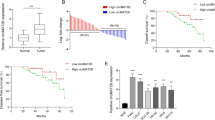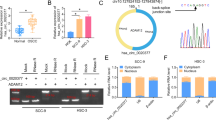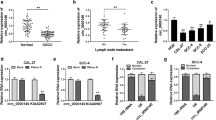Abstract
Emerging evidence has demonstrated the pivotal roles of circular RNAs (circRNAs) in the modulation of malignancy and pathological progression among multiple human cancers. Glucose metabolism reprogramming is a widely identified characteristic for contributing to facilitate tumorigenesis. Nonetheless, their contributions to head and neck squamous cell carcinoma (HNSCC) cell glycolysis remain to be further elucidated. Herein, we aim to investigate the role of circRNA, hsa_circ_0018180 (also named as circPARD3) in HNSCC. Expression patterns of circPARD3 in HNSCC tissues and different cell lines were determined by qRT-PCR assay, as well as its correlation with the prognosis of survival. CCK-8, EdU incorporation, and transwell assays were carried out to assess the cell viability, proliferation, migration, and invasion, respectively. Glucose uptake and lactate production were evaluated by preforming glycolysis. Mechanistically, the circPARD3/miR-5194/ENO1 axis was verified by RNA immunoprecipitation (RIP) and luciferase reporter assays. Western blot analysis was employed to measure the epithelial-mesenchymal transition (EMT)-associated biomarkers. Upregulated circPARD3 observed in HNSCC tissues and cell lines indicated the poor prognosis of patients. Stable knockdown of circPARD3 dramatically exerted the suppressive effects on cell viability, proliferation, migration, and invasion, as well as glucose uptake and lactate production. Mechanistically, circPARD3 harbored miR-5194, serving as a miRNA sponge, thereby increasing ENO1 expression. Moreover, ENO1 evidently reversed miR-5194-mediated attenuated malignant behaviors. Collectively, our study identified an oncogenic role of circPARD3 in HNSCC through a novel machinery of circPARD3/miR-5194/ENO1 and provided a promising therapeutic target for HNSCC.







Similar content being viewed by others
References
Cao L, Wang M, Dong Y, Xu B, Chen J, Ding Y et al (2020) Circular RNA circRNF20 promotes breast cancer tumorigenesis and Warburg effect through miR-487a/HIF-1alpha/HK2. Cell Death Dis 11:145
Chaturvedi AK, Engels EA, Pfeiffer RM, Hernandez BY, Xiao W, Kim E et al (2011) Human papillomavirus and rising oropharyngeal cancer incidence in the United States. J Clin Oncol 29:4294–4301
Cramer JD, Burtness B, Le QT, Ferris RL (2019) The changing therapeutic landscape of head and neck cancer. Nat Rev Clin Oncol 16:669–683
Fitzpatrick JM, Hayes N, Naughton C, Ezhova I (2021) Evaluating a specialist education programme for nurses and allied health professionals working in older people care: a qualitative analysis of motivations and impact. Nurse Educ Today 97:104708
Gao W, Guo H, Niu M, Zheng X, Zhang Y, Xue X et al (2020) circPARD3 drives malignant progression and chemoresistance of laryngeal squamous cell carcinoma by inhibiting autophagy through the PRKCI-Akt-mTOR pathway. Mol Cancer 19:166
Hanahan D, Weinberg RA (2011) Hallmarks of cancer: the next generation. Cell 144:646–674
Hao Y, Zhang D, Guo Y, Fu Z, Yu D, Guan G (2020) miR-488-3p sponged by circ-0000495 and mediated upregulation of TROP2 in head and neck squamous cell carcinoma development. J Cancer 11:3375–3386
Hong J, Guo F, Lu SY, Shen C, Ma D, Zhang X et al (2021) F. nucleatum targets lncRNA ENO1-IT1 to promote glycolysis and oncogenesis in colorectal cancer. Gut 70:2123–2137
Hu T, Liu H, Liang Z, Wang F, Zhou C, Zheng X et al (2020) Tumor-intrinsic CD47 signal regulates glycolysis and promotes colorectal cancer cell growth and metastasis. Theranostics 10:4056–4072
Li Q, Pan X, Zhu D, Deng Z, Jiang R, Wang X (2019) Circular RNA MAT2B promotes glycolysis and malignancy of hepatocellular carcinoma through the miR-338-3p/PKM2 axis under hypoxic stress. Hepatology 70:1298–1316
Ma C, Shi T, Qu Z, Zhang A, Wu Z, Zhao H et al (2020) CircRNA_ACAP2 suppresses EMT in head and neck squamous cell carcinoma by targeting the miR-21-5p/STAT3 signaling axis. Front Oncol 10:583682
Maier H, Dietz A, Gewelke U, Heller WD, Weidauer H (1992) Tobacco and alcohol and the risk of head and neck cancer. Clin Investig 70:320–327
Orang AV, Petersen J, McKinnon RA, Michael MZ (2019) Micromanaging aerobic respiration and glycolysis in cancer cells. Mol Metab 23:98–126
Pancholi V (2001) Multifunctional alpha-enolase: its role in diseases. Cell Mol Life Sci 58:902–920
Shen J, Jin Z, Lv H, Jin K, Jonas K, Zhu C et al (2020) PFKP is highly expressed in lung cancer and regulates glucose metabolism. Cell Oncol 43:617–629
Siegel RL, Miller KD, Jemal A (2016) Cancer statistics, 2016. CA Cancer J Clin 66:7–30
Siegel RL, Miller KD, Jemal A (2018) Cancer statistics, 2018. CA Cancer J Clin 68:7–30
Tabibkhooei A, Izadpanahi M, Arab A, Zare-Mirzaei A, Minaeian S, Rostami A et al (2020) Profiling of novel circulating microRNAs as a non-invasive biomarker in diagnosis and follow-up of high and low-grade gliomas. Clin Neurol Neurosurg 190:105652
Wang Y, Hou J, He D, Sun M, Zhang P, Yu Y et al (2016) The emerging function and mechanism of ceRNAs in cancer. Trends Genet 32:211–224
Wang WL, Yang Z, Zhang YJ, Lu P, Ni YK, Sun CF et al (2018) Competing endogenous RNA analysis reveals the regulatory potency of circRNA_036186 in HNSCC. Int J Oncol 53:1529–1543
Wang L, Li H, Qiao Q, Ge Y, Ma L, Wang Q (2020) Circular RNA circSEMA5A promotes bladder cancer progression by upregulating ENO1 and SEMA5A expression. Aging 12:21674–21686
Wu Z, Wu J, Zhao Q, Fu S, Jin J (2020) Emerging roles of aerobic glycolysis in breast cancer. Clin Transl Oncol 22:631–646
Yu S, Hu C, Cai L, Du X, Lin F, Yu Q et al (2020) Seven-gene signature based on glycolysis is closely related to the prognosis and tumor immune infiltration of patients with gastric cancer. Front Oncol 10:1778
Zhang S, Zhu D, Li H, Li H, Feng C, Zhang W (2017) Characterization of circRNA-associated-ceRNA networks in a senescence-accelerated mouse prone 8 brain. Mol Ther 25:2053–2061
Zhang K, Hu H, Xu J, Qiu L, Chen H, Jiang X et al (2020) Circ_0001421 facilitates glycolysis and lung cancer development by regulating miR-4677-3p/CDCA3. Diagn Pathol 15:133
Zhou J, Zhang S, Chen Z, He Z, Xu Y, Li Z (2019) CircRNA-ENO1 promoted glycolysis and tumor progression in lung adenocarcinoma through upregulating its host gene ENO1. Cell Death Dis 10:885
Zhu X, Miao X, Wu Y, Li C, Guo Y, Liu Y et al (2015) ENO1 promotes tumor proliferation and cell adhesion mediated drug resistance (CAM-DR) in Non-Hodgkin’s Lymphomas. Exp Cell Res 335:216–223
Funding
This study was supported by the Natural Science Foundation of China (Nos. 82073006, 81902757, 82002757).
Author information
Authors and Affiliations
Contributions
J-TL: Conceptualization; Writing-original draft; Methodology; Formal analysis; Y-fW: Supervision; Validation; YW, R-YL: Data curation; Resources; C-LW: Investigation; ZZ: Funding acquisition; Project administration; Writing-review & editing. All authors have read and approved the final version of this manuscript to be published.
Corresponding authors
Ethics declarations
Conflict of interest
The authors declare that there are no conflicts of interest.
Ethical Approval
This study was approved by the Ethics Committee of Tianjin Cancer Hospital in accordance to the Declaration of Helsinki. All experiments involving the clinical patients were conducted on the order with provisions of the Declaration of Helsinki and Good Clinical Practice guidelines.
Additional information
Publisher's Note
Springer Nature remains neutral with regard to jurisdictional claims in published maps and institutional affiliations.
Supplementary Information
Below is the link to the electronic supplementary material.
10528_2022_10253_MOESM1_ESM.tif
Supplementary file1 Figure S1. Verification of circPARD3/miR-5194/ENO1 axis. (A) circPARD3 in the HN30 and SCC-25 cell lysates was pulled down and enriched with circPARD3 specific probe and then assessed by qRT-PCR. (B and C) The relative five candidate miRNAs in the HN30 and SCC-25 cell lysates were measured by qRT-PCR. (D) The biotinylated miR-5193 was transfected into HN30 and SCC-25 cells, and the enrichment of circpARD3 was quantified by qRT-PCR. (E) Dual-luciferase reporter assay in 293T cells was used to validate the binding relationship of circPARD3 and miR-5194. (F) Dual-luciferase reporter gene system in 293T cells for examining the binding sites between miR-5194 and ENO1. Data were representative images or were expressed as the mean ± SD of n = 3 experiments. *, P < 0.05, **, P < 0.01, ***, P < 0.001. (TIF 338 kb)
Rights and permissions
About this article
Cite this article
Luo, JT., Wang, Yf., Wang, Y. et al. A Circular RNA, hsa_circ_0018180 (circPARD3), Triggers Glycolysis and Promotes Malignancy of Head and Neck Squamous Cell Carcinoma Through the miR-5194/ENO1 Axis. Biochem Genet 61, 316–335 (2023). https://doi.org/10.1007/s10528-022-10253-0
Received:
Accepted:
Published:
Issue Date:
DOI: https://doi.org/10.1007/s10528-022-10253-0




